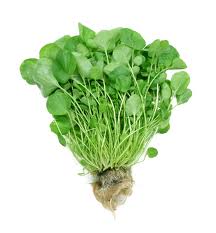 Watercress is an amazingly nutritios leafy vegetable packed with vitamin C, calcium, iron and folate. In fact, watercress contains more vitamin C than oranges when compared in terms of 100 grams, and contains more calcium than a glass of milk. As the name implies, watercress requires water to grow. Water which is packed with mineral rich vitamins tends to promote a more nutritious leaf. As a superfood, watercress has quite the history.
Watercress is an amazingly nutritios leafy vegetable packed with vitamin C, calcium, iron and folate. In fact, watercress contains more vitamin C than oranges when compared in terms of 100 grams, and contains more calcium than a glass of milk. As the name implies, watercress requires water to grow. Water which is packed with mineral rich vitamins tends to promote a more nutritious leaf. As a superfood, watercress has quite the history.
Cultivated since ancient Greek times, watercress was a favorite of Hippocrates, the father of modern day medicine. This ancient Greek doctor was known to grow vast amounts of watercress to serve to his patients due to its high mineral content and ability to cure many ancient ailments. In addition to its nutrition content, watercress is a delicious leaf with a unique peppery taste.
Key Nutrients
Watercress provides a high amount of vitamin B6, vitamin C, manganese and carotenes. It also provides a high amount of iron, copper and calcium. Watercress is also a great source of dietary fiber, especially when consumed in its raw form.
Health Benefits
Manganese – Manganese aids in the metabolism of food as well as promotes normal functioning of the nervous system. Manganese works as an antixoidant to help prevent cancer and heart disease.
Beta Carotene – Beta carotene has been well-studied as a dietary antioxidant. Carotenoids are also thought to benefit eye health. Some studies support a role of carotenoids in reducing macular degeneration.
Vitamin B6 – Vitamin B6 helps to keep your immune system in good working order. It aids in the breakdown of fats, carbohydrates and amino acids while helping to maintain the health of lymph nodes. Additionally, vitamin B6 helps to regulate blood glucose levels.
Vitamin C – Regular consumption of foods rich in vitamin C helps the body develop resistance against infections and scavenges harmful, pro-inflammatory free radicals. Vitamin C also helps to prevent respiratory problems such as asthma and lung cancer. Vitamin C has been shown to lower blood pressure, and therefore lessen the probability of hypertension.
Season
Watercress is grown in the spring, summer and fall. Due to its ease of growth, it is easy to find watercress in supermarkets year round.
Nutrition Information
Per 1 Cup (34 grams):
Calories (cKal): 4
Protein (grams): .78
Total Fat (grams): .03
Carbohydrates (grams): .44
Fiber (grams): .2
Buying and Storing
When buying watercress, make sure the bunches are well hydrated in water on the supermarket shelf. You should also look out for wilted and rotten leaves, since this tends to demonstrate old age. When storing at home, it is important to refrigerate watercress in a container full of water. Adding ice to the container will prolong the life of the watercress to up to five days.
Best Way to Add to Diet
Watercress makes a great addition to salad greens, giving texture as well as an extra peppery taste. Watercress also makes a great soup full of vitamins and minerals. Finally, watercress, with its refreshing taste, compliments a meal of steak, potatoes and roasted tomatoes.
Watercress Recipe
Watercress Salad with Avocado and Peanuts

 Not Sure What Healthy Foods To Eat?
Not Sure What Healthy Foods To Eat? This week we take a look at one of my favorite healthy foods...the mighty Avocado.
This week we take a look at one of my favorite healthy foods...the mighty Avocado.
No comments yet.